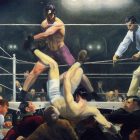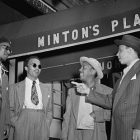An Incredibly Brief Introduction to New Media Lit
Let us consider a form mired in its indefinability: new media lit. I’ve found that nothing – not even poetry – can alienate a reader more quickly than encountering it. Normally I would resist trying to encapsulate an entire genre into one shell of a definition, but because we don’t have a lot of time here and my purpose is simply to expose you to the very distant edge of what the genre has to offer (whether you choose to step further is up to you), let’s stick with a radically basic, extremely flawed definition: New media lit is any “literature” that appears online, utilizing the myriad tools of technology and often allowing a greater degree of reader interaction than does offline literature.
This stuff has been around for a while—since Michael Joyce first doled out a floppy disk to his peers bearing the first (arguably) hypertext story entitled “Afternoon, a Story” in the late ’80s—but only on the fringes of literature, existing more as a novelty than as a respectable form. Robert Coover hailed its potential more than anyone, seeing it as perhaps the natural evolution of literature—the product of emerging media and our increased connectedness to technology. At a certain point in the 1990s, for some, new media lit seemed to be the inevitable future.
It was a future that never came to pass. But today, as digital literacy and the capacity for multimodal thought processing increases light years with each new generation beyond the previous one, I think it’s worth dipping into the digital waters again, if only to challenge our notion of what literature is and consider what else it can, and might, one day be.
New media lit can take many forms: a game, a visual poem, a moving story, even a piece of software. It takes advantage of a confluence of artistic elements usually, incorporating more than one component; for example, beyond mere language a poem might include sound, text effects, or animation.
To date, new media lit still exists in that weird avant garde artsy-fartsy space trapped between not-at-all-marketable and as-a-reader-I-don’t-know-how-to-enter-this-work-and-I-have-a-feeling-the-creator-knew-that-when-they-made-it-but-didn’t-care. (And that might be the most succinct summation of its most dire drawbacks.) As readers, we’re accustomed to reading in certain directions: up to down, left to right, turn page. But with new media lit, suddenly all kinds of strange new directions are possible, and this is inherently overwhelming for most readers. It’s hard enough to tell a good story, it’s even harder when you’re trying to teach readers a new mode of reading entirely that incorporates more than just text, but visual, aural, even kinesthetic elements, and to do so entertainingly. What I predict in the next few years is that mode of reading made more mainstream through the proliferation of more entertaining, accessible new media works.
But while we’re waiting for the future, here’s a brief list of some of my favorite new media projects floating around the internet, an eclectic cross section of well-made works meant to demonstrate the wondrous variety and diversity the form has to offer. (Some might not consider a game literary or even new media lit; this particular reader, however, does…)
TAILSPIN
“A story of intergenerational conflict unfolds through sound as a woman negotiates between her father, who was ‘nothing more than an aircraft fitter’ during WWII, and her children, who are often absorbed by their games and frightened by his anger at the noise that they make.”
THE “GAMES” OF JASON NELSON
Deconstructed “games” that challenge the notion of what a game even is.
SEPARATION
“The text seems to be about a separation between human beings, only the last two phrases reveal that it’s about a separation between a human being and a computer.”
Note: It may seem like it’s not working but it is: you have to interact with the screen to make stuff happen.
THE END
“A game about mortality that asks big questions.”
MY BODY – A WUNDERKAMMER
“A semi-autobiographical hypertext combining text and image in an exploration of the body.”
PIECES OF HERSELF
“An exploration of feminine embodiment and identity in relationship to public and private space.”
**Find more new media lit worth finding by browsing the Electronic Literature Collection and Games for Change




